2001 NISSAN X-TRAIL sensor
[x] Cancel search: sensorPage 3399 of 3833
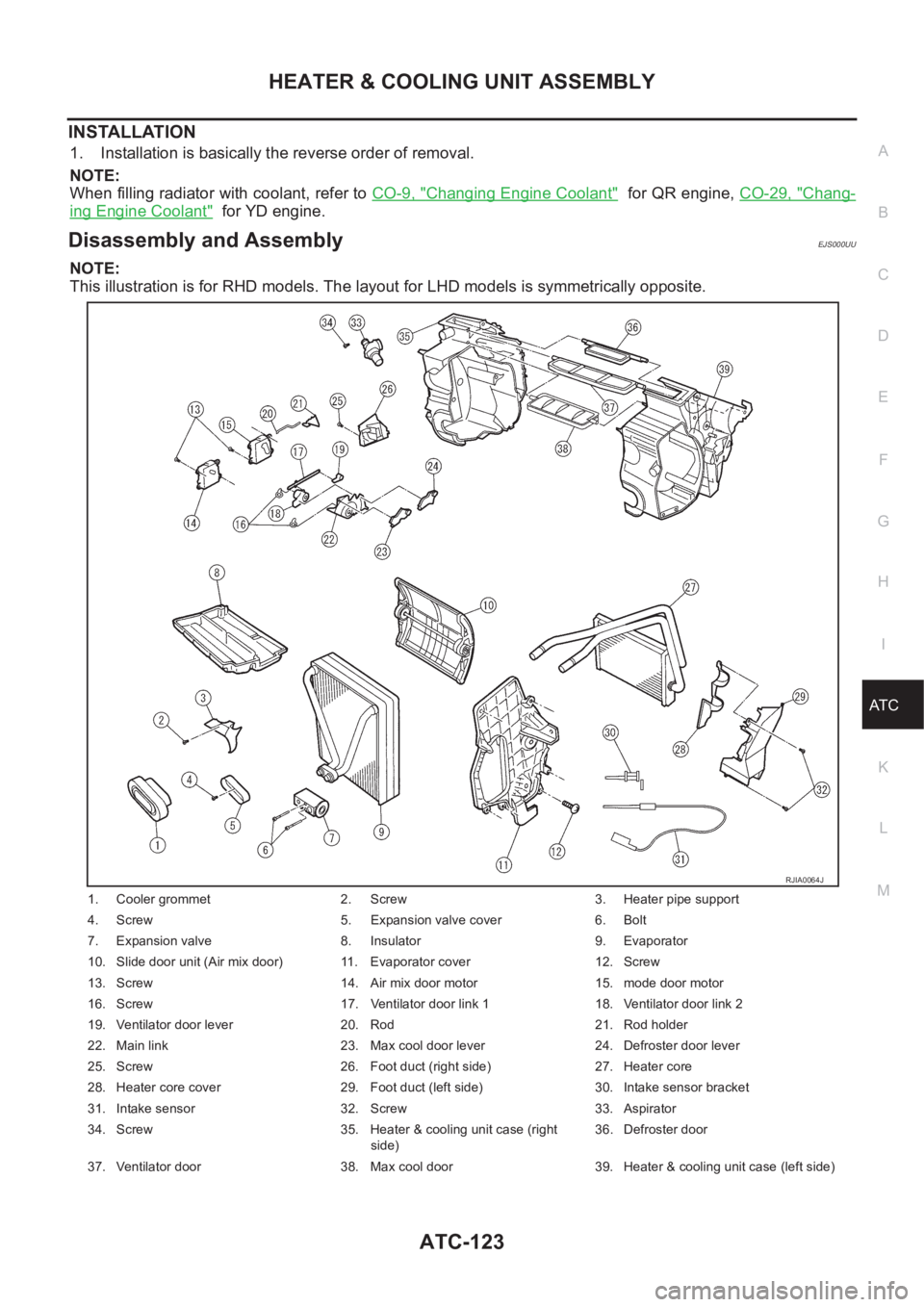
HEATER & COOLING UNIT ASSEMBLY
ATC-123
C
D
E
F
G
H
I
K
L
MA
B
AT C
INSTALLATION
1. Installation is basically the reverse order of removal.
NOTE:
When filling radiator with coolant, refer to CO-9, "
Changing Engine Coolant" for QR engine, CO-29, "Chang-
ing Engine Coolant" for YD engine.
Disassembly and AssemblyEJS000UU
NOTE:
This illustration is for RHD models. The layout for LHD models is symmetrically opposite.
1. Cooler grommet 2. Screw 3. Heater pipe support
4. Screw 5. Expansion valve cover 6. Bolt
7. Expansion valve 8. Insulator 9. Evaporator
10. Slide door unit (Air mix door) 11. Evaporator cover 12. Screw
13. Screw 14. Air mix door motor 15. mode door motor
16. Screw 17. Ventilator door link 1 18. Ventilator door link 2
19. Ventilator door lever 20. Rod 21. Rod holder
22. Main link 23. Max cool door lever 24. Defroster door lever
25. Screw 26. Foot duct (right side) 27. Heater core
28. Heater core cover 29. Foot duct (left side) 30. Intake sensor bracket
31. Intake sensor 32. Screw 33. Aspirator
34. Screw 35. Heater & cooling unit case (right
side)36. Defroster door
37. Ventilator door 38. Max cool door 39. Heater & cooling unit case (left side)
RJIA0064J
Page 3419 of 3833
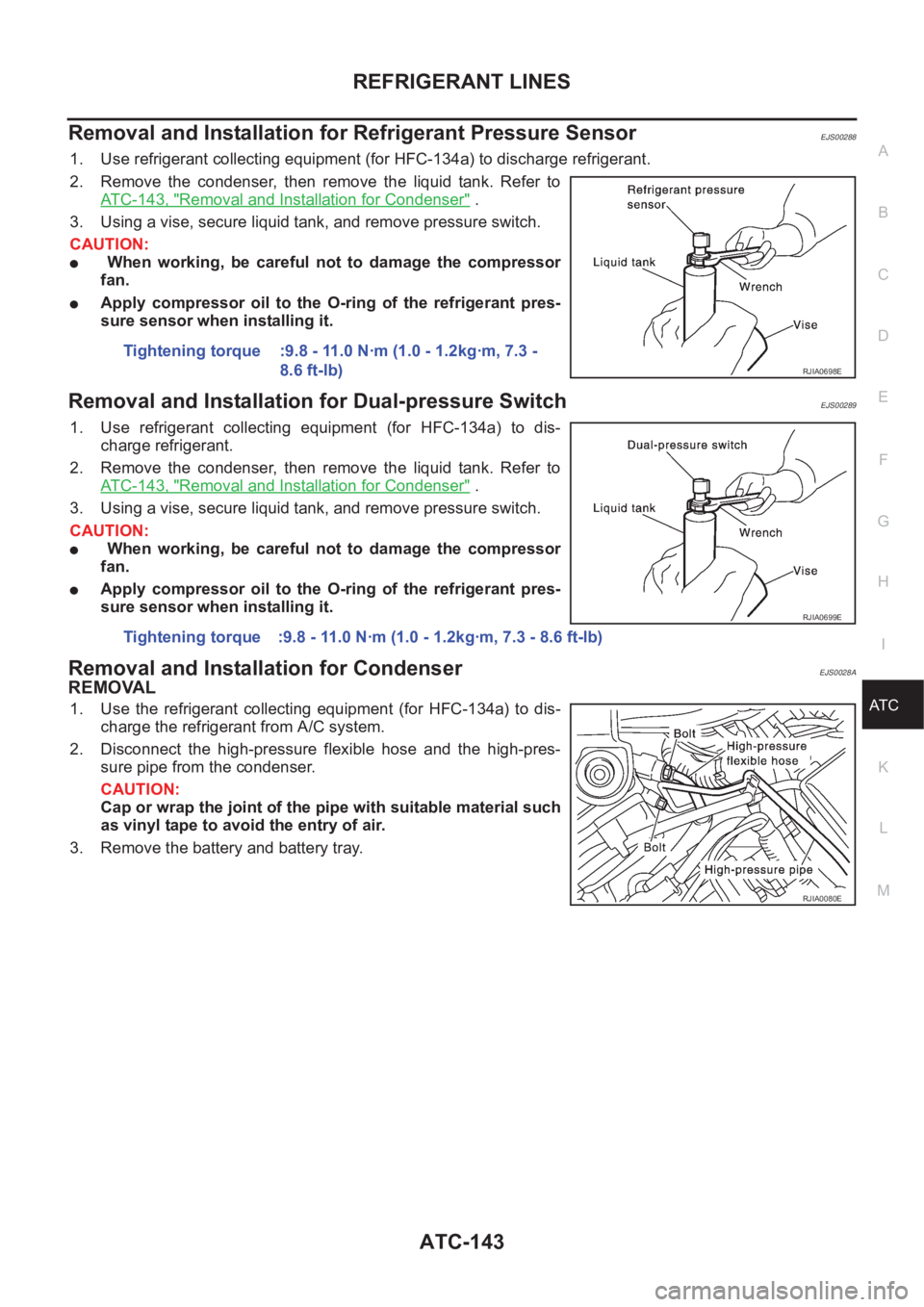
REFRIGERANT LINES
ATC-143
C
D
E
F
G
H
I
K
L
MA
B
AT C
Removal and Installation for Refrigerant Pressure SensorEJS00288
1. Use refrigerant collecting equipment (for HFC-134a) to discharge refrigerant.
2. Remove the condenser, then remove the liquid tank. Refer to
ATC-143, "
Removal and Installation for Condenser" .
3. Using a vise, secure liquid tank, and remove pressure switch.
CAUTION:
● When working, be careful not to damage the compressor
fan.
●Apply compressor oil to the O-ring of the refrigerant pres-
sure sensor when installing it.
Removal and Installation for Dual-pressure SwitchEJS00289
1. Use refrigerant collecting equipment (for HFC-134a) to dis-
charge refrigerant.
2. Remove the condenser, then remove the liquid tank. Refer to
ATC-143, "
Removal and Installation for Condenser" .
3. Using a vise, secure liquid tank, and remove pressure switch.
CAUTION:
● When working, be careful not to damage the compressor
fan.
●Apply compressor oil to the O-ring of the refrigerant pres-
sure sensor when installing it.
Removal and Installation for CondenserEJS0028A
REMOVAL
1. Use the refrigerant collecting equipment (for HFC-134a) to dis-
charge the refrigerant from A/C system.
2. Disconnect the high-pressure flexible hose and the high-pres-
sure pipe from the condenser.
CAUTION:
Cap or wrap the joint of the pipe with suitable material such
as vinyl tape to avoid the entry of air.
3. Remove the battery and battery tray.Tightening torque :9.8 - 11.0 N·m (1.0 - 1.2kg·m, 7.3 -
8.6 ft-lb)
RJIA0698E
Tightening torque :9.8 - 11.0 N·m (1.0 - 1.2kg·m, 7.3 - 8.6 ft-lb)
RJIA0699E
RJIA0080E
Page 3420 of 3833
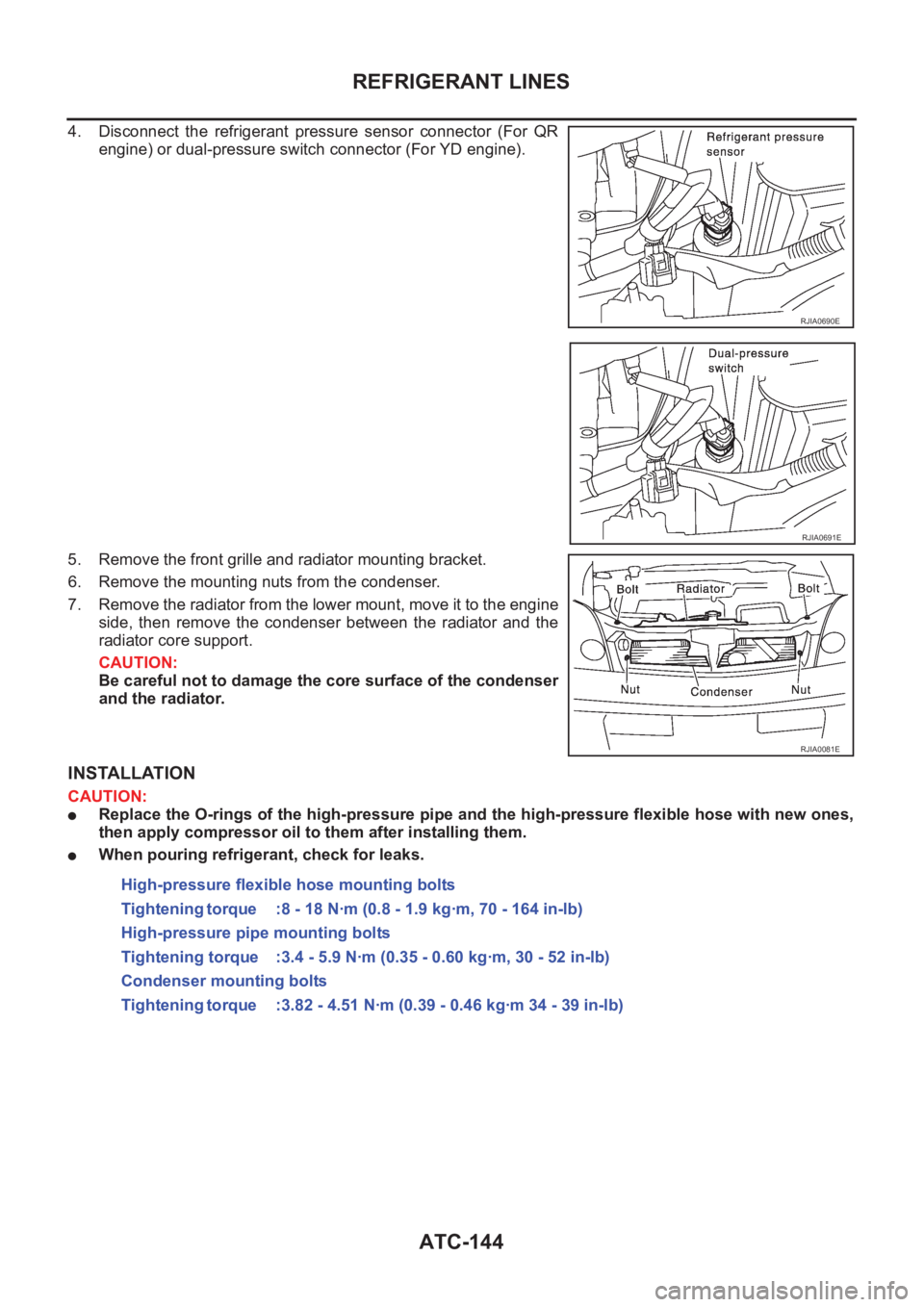
ATC-144
REFRIGERANT LINES
4. Disconnect the refrigerant pressure sensor connector (For QR
engine) or dual-pressure switch connector (For YD engine).
5. Remove the front grille and radiator mounting bracket.
6. Remove the mounting nuts from the condenser.
7. Remove the radiator from the lower mount, move it to the engine
side, then remove the condenser between the radiator and the
radiator core support.
CAUTION:
Be careful not to damage the core surface of the condenser
and the radiator.
INSTALLATION
CAUTION:
●Replace the O-rings of the high-pressure pipe and the high-pressure flexible hose with new ones,
then apply compressor oil to them after installing them.
●When pouring refrigerant, check for leaks.
RJIA0690E
RJIA0691E
RJIA0081E
High-pressure flexible hose mounting bolts
Tightening torque :8 - 18 N·m (0.8 - 1.9 kg·m, 70 - 164 in-lb)
High-pressure pipe mounting bolts
Tightening torque :3.4 - 5.9 N·m (0.35 - 0.60 kg·m, 30 - 52 in-lb)
Condenser mounting bolts
Tightening torque :3.82 - 4.51 N·m (0.39 - 0.46 kg·m 34 - 39 in-lb)
Page 3421 of 3833
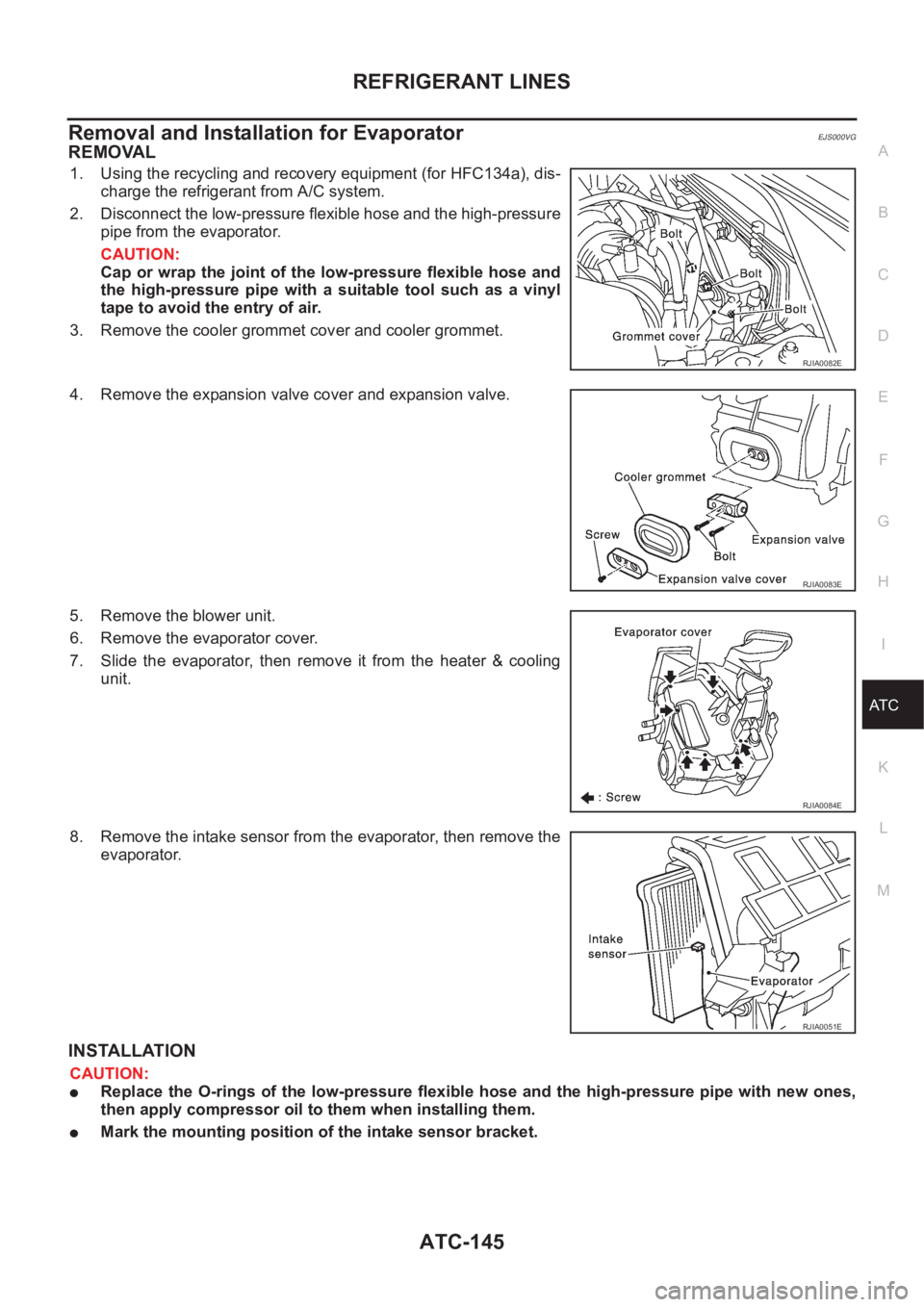
REFRIGERANT LINES
ATC-145
C
D
E
F
G
H
I
K
L
MA
B
AT C
Removal and Installation for EvaporatorEJS000VG
REMOVAL
1. Using the recycling and recovery equipment (for HFC134a), dis-
charge the refrigerant from A/C system.
2. Disconnect the low-pressure flexible hose and the high-pressure
pipe from the evaporator.
CAUTION:
Cap or wrap the joint of the low-pressure flexible hose and
the high-pressure pipe with a suitable tool such as a vinyl
tape to avoid the entry of air.
3. Remove the cooler grommet cover and cooler grommet.
4. Remove the expansion valve cover and expansion valve.
5. Remove the blower unit.
6. Remove the evaporator cover.
7. Slide the evaporator, then remove it from the heater & cooling
unit.
8. Remove the intake sensor from the evaporator, then remove the
evaporator.
INSTALLATION
CAUTION:
●Replace the O-rings of the low-pressure flexible hose and the high-pressure pipe with new ones,
then apply compressor oil to them when installing them.
●Mark the mounting position of the intake sensor bracket.
RJIA0082E
RJIA0083E
RJIA0084E
RJIA0051E
Page 3423 of 3833
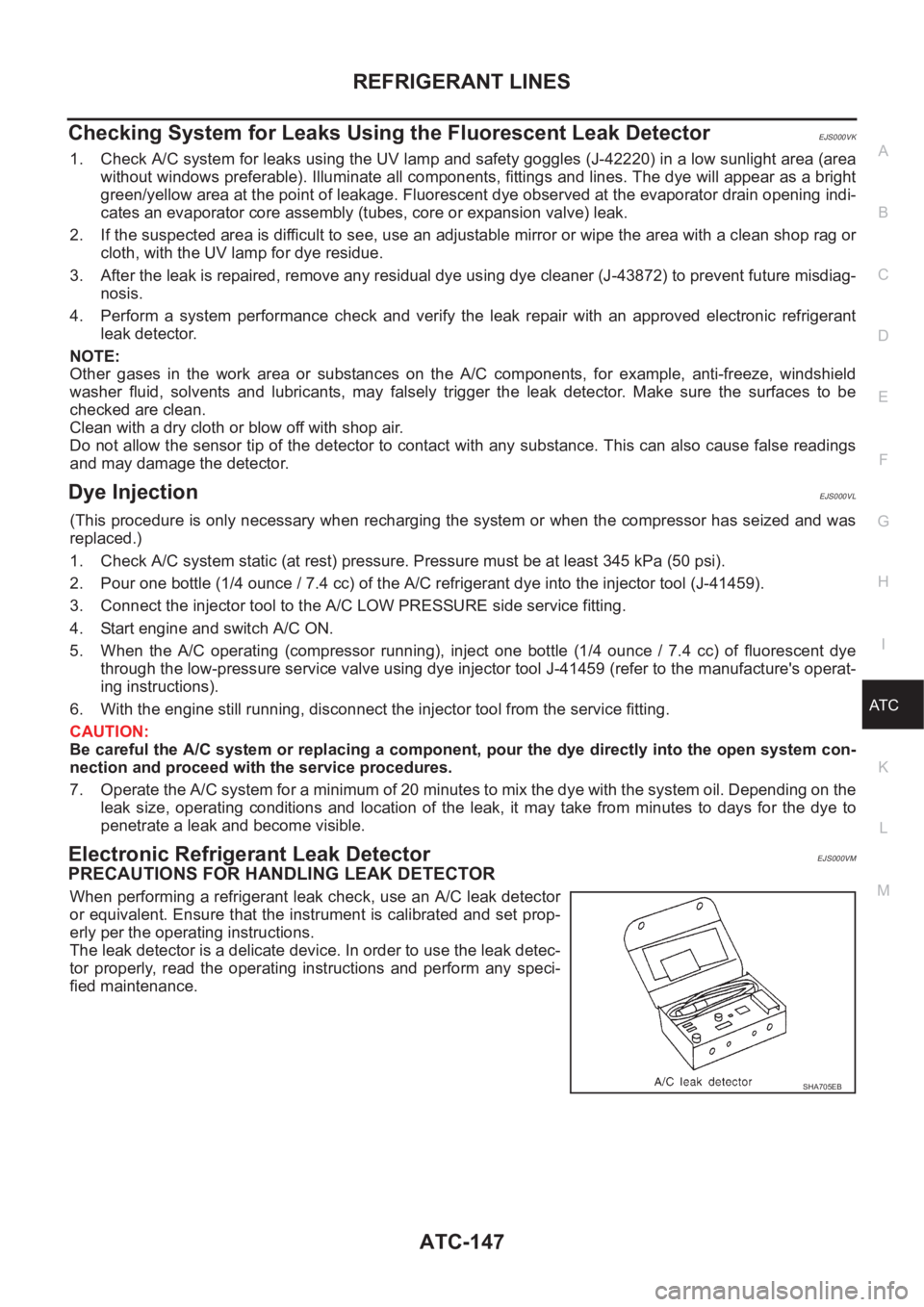
REFRIGERANT LINES
ATC-147
C
D
E
F
G
H
I
K
L
MA
B
AT C
Checking System for Leaks Using the Fluorescent Leak DetectorEJS000VK
1. Check A/C system for leaks using the UV lamp and safety goggles (J-42220) in a low sunlight area (area
without windows preferable). Illuminate all components, fittings and lines. The dye will appear as a bright
green/yellow area at the point of leakage. Fluorescent dye observed at the evaporator drain opening indi-
cates an evaporator core assembly (tubes, core or expansion valve) leak.
2. If the suspected area is difficult to see, use an adjustable mirror or wipe the area with a clean shop rag or
cloth, with the UV lamp for dye residue.
3. After the leak is repaired, remove any residual dye using dye cleaner (J-43872) to prevent future misdiag-
nosis.
4. Perform a system performance check and verify the leak repair with an approved electronic refrigerant
leak detector.
NOTE:
Other gases in the work area or substances on the A/C components, for example, anti-freeze, windshield
washer fluid, solvents and lubricants, may falsely trigger the leak detector. Make sure the surfaces to be
checked are clean.
Clean with a dry cloth or blow off with shop air.
Do not allow the sensor tip of the detector to contact with any substance. This can also cause false readings
and may damage the detector.
Dye InjectionEJS000VL
(This procedure is only necessary when recharging the system or when the compressor has seized and was
replaced.)
1. Check A/C system static (at rest) pressure. Pressure must be at least 345 kPa (50 psi).
2. Pour one bottle (1/4 ounce / 7.4 cc) of the A/C refrigerant dye into the injector tool (J-41459).
3. Connect the injector tool to the A/C LOW PRESSURE side service fitting.
4. Start engine and switch A/C ON.
5. When the A/C operating (compressor running), inject one bottle (1/4 ounce / 7.4 cc) of fluorescent dye
through the low-pressure service valve using dye injector tool J-41459 (refer to the manufacture's operat-
ing instructions).
6. With the engine still running, disconnect the injector tool from the service fitting.
CAUTION:
Be careful the A/C system or replacing a component, pour the dye directly into the open system con-
nection and proceed with the service procedures.
7. Operate the A/C system for a minimum of 20 minutes to mix the dye with the system oil. Depending on the
leak size, operating conditions and location of the leak, it may take from minutes to days for the dye to
penetrate a leak and become visible.
Electronic Refrigerant Leak DetectorEJS000VM
PRECAUTIONS FOR HANDLING LEAK DETECTOR
When performing a refrigerant leak check, use an A/C leak detector
or equivalent. Ensure that the instrument is calibrated and set prop-
erly per the operating instructions.
The leak detector is a delicate device. In order to use the leak detec-
tor properly, read the operating instructions and perform any speci-
fied maintenance.
SHA705EB
Page 3424 of 3833
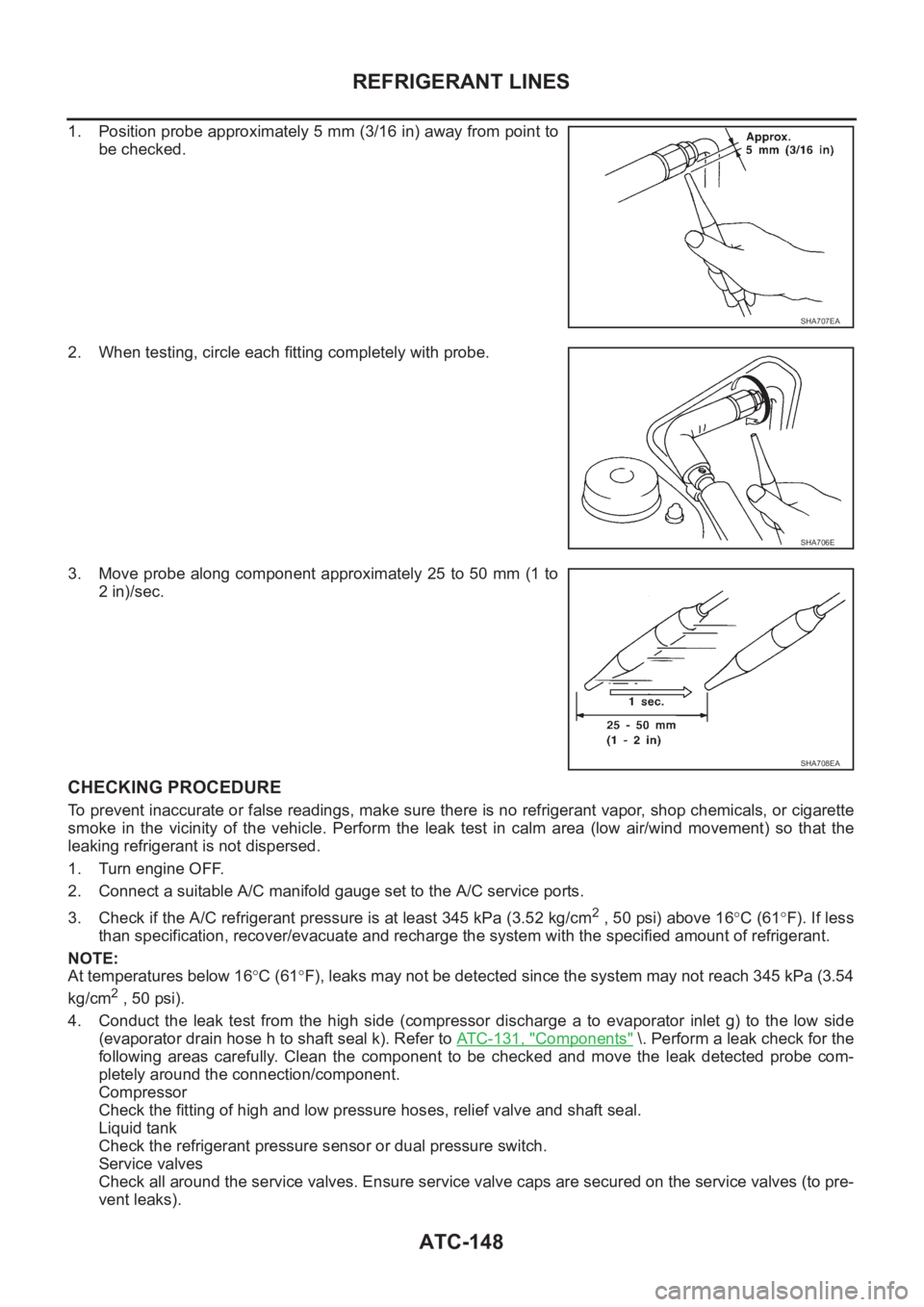
ATC-148
REFRIGERANT LINES
1. Position probe approximately 5 mm (3/16 in) away from point to
be checked.
2. When testing, circle each fitting completely with probe.
3. Move probe along component approximately 25 to 50 mm (1 to
2 in)/sec.
CHECKING PROCEDURE
To prevent inaccurate or false readings, make sure there is no refrigerant vapor, shop chemicals, or cigarette
smoke in the vicinity of the vehicle. Perform the leak test in calm area (low air/wind movement) so that the
leaking refrigerant is not dispersed.
1. Turn engine OFF.
2. Connect a suitable A/C manifold gauge set to the A/C service ports.
3. Check if the A/C refrigerant pressure is at least 345 kPa (3.52 kg/cm
2 , 50 psi) above 16°C (61°F). If less
than specification, recover/evacuate and recharge the system with the specified amount of refrigerant.
NOTE:
At temperatures below 16°C (61°F), leaks may not be detected since the system may not reach 345 kPa (3.54
kg/cm
2 , 50 psi).
4. Conduct the leak test from the high side (compressor discharge a to evaporator inlet g) to the low side
(evaporator drain hose h to shaft seal k). Refer to ATC-131, "
Components" \. Perform a leak check for the
following areas carefully. Clean the component to be checked and move the leak detected probe com-
pletely around the connection/component.
Compressor
Check the fitting of high and low pressure hoses, relief valve and shaft seal.
Liquid tank
Check the refrigerant pressure sensor or dual pressure switch.
Service valves
Check all around the service valves. Ensure service valve caps are secured on the service valves (to pre-
vent leaks).
SHA707EA
SHA706E
SHA708EA
Page 3445 of 3833

TROUBLE DIAGNOSIS
MTC-19
C
D
E
F
G
H
I
K
L
MA
B
MTC
*1 QR engine; CO-9, "Changing Engine
Coolant" .
YD engine; CO-29, "
Changing
Engine Coolant" .*2 QR engine; CO-12, "
Checking Radi-
ator Cap"
YD engine; CO-33, "Checking Radi-
ator Cap" .*3 QR25 engine; (WITH EURO-OBD)
EC-153, "
ENGINE COOLANT TEM-
PERATURE SENSOR" .
QR25 engine; (WITHOOUT EUR-
OBD)EC-527, "
ENGINE COOLANT
TEMPERATURE SENSOR" .
QR20 engine; (WITH EURO-OBD)
EC-885, "
ENGINE COOLANT TEM-
PERATURE SENSOR" .
QR20 engine; (WITHOUT EURO-
OBD)EC-1213, "
ENGINE COOLANT
TEMPERATURE SENSOR" .
YD engine; EC-1508, "
SYSTEM
DESCRIPTION" .
*4 QR engine; CO-9, "
Changing Engine
Coolant" .
YD engine; CO-29, "
Changing
Engine Coolant" .*5 MTC-7, "
Operational Check"*6MTC-3, "SYMPTOM TABLE"
Page 3545 of 3833
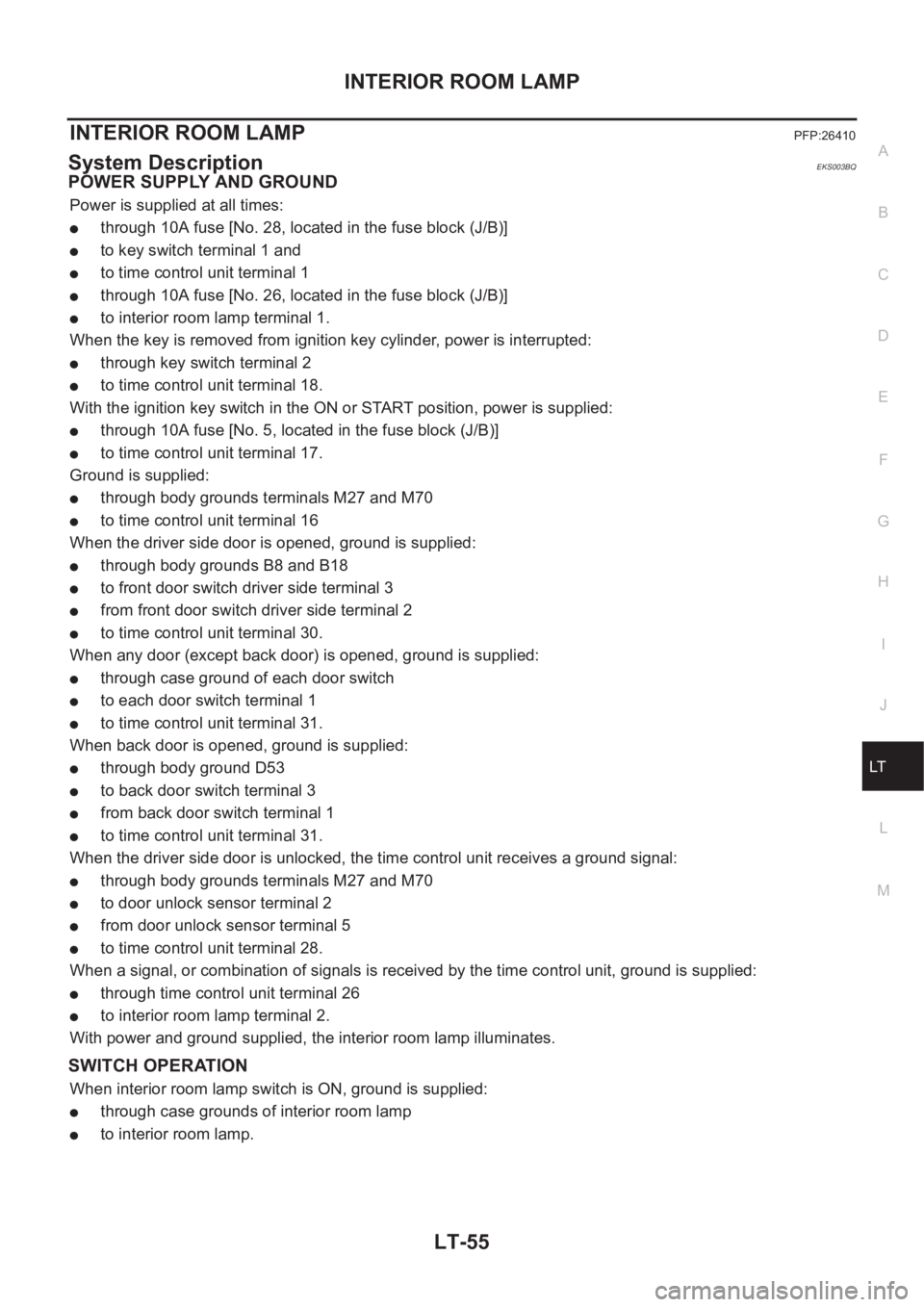
INTERIOR ROOM LAMP
LT-55
C
D
E
F
G
H
I
J
L
MA
B
LT
INTERIOR ROOM LAMPPFP:26410
System DescriptionEKS003BQ
POWER SUPPLY AND GROUND
Power is supplied at all times:
●through 10A fuse [No. 28, located in the fuse block (J/B)]
●to key switch terminal 1 and
●to time control unit terminal 1
●through 10A fuse [No. 26, located in the fuse block (J/B)]
●to interior room lamp terminal 1.
When the key is removed from ignition key cylinder, power is interrupted:
●through key switch terminal 2
●to time control unit terminal 18.
With the ignition key switch in the ON or START position, power is supplied:
●through 10A fuse [No. 5, located in the fuse block (J/B)]
●to time control unit terminal 17.
Ground is supplied:
●through body grounds terminals M27 and M70
●to time control unit terminal 16
When the driver side door is opened, ground is supplied:
●through body grounds B8 and B18
●to front door switch driver side terminal 3
●from front door switch driver side terminal 2
●to time control unit terminal 30.
When any door (except back door) is opened, ground is supplied:
●through case ground of each door switch
●to each door switch terminal 1
●to time control unit terminal 31.
When back door is opened, ground is supplied:
●through body ground D53
●to back door switch terminal 3
●from back door switch terminal 1
●to time control unit terminal 31.
When the driver side door is unlocked, the time control unit receives a ground signal:
●through body grounds terminals M27 and M70
●to door unlock sensor terminal 2
●from door unlock sensor terminal 5
●to time control unit terminal 28.
When a signal, or combination of signals is received by the time control unit, ground is supplied:
●through time control unit terminal 26
●to interior room lamp terminal 2.
With power and ground supplied, the interior room lamp illuminates.
SWITCH OPERATION
When interior room lamp switch is ON, ground is supplied:
●through case grounds of interior room lamp
●to interior room lamp.